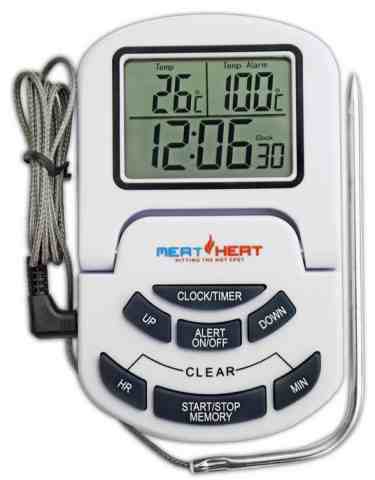I don’t want this to sound like a lecture, but if you have a few of these major points in your head, you can easily avoid any danger from bacteria. Under certain conditions they can multiply rapidly and become a hazard. Take a few tips from the professionals and look after your family or party guests….
Foods most easily affected are meat, poultry, eggs, seafood, dairy products, cut melon, raw seed sprouts, garlic-in-oil mixtures, cooked rice and potatoes. So given that Halogen ovens are perfect for cooking and reheating leftovers, we do need to know the limits of temperature and time to make sure we are safe.
Hot Food
When your hot food is ready, it should have an internal temperature above 140 F , if you don’t serve it immediately and use a food warmer, be careful to choose one which keeps food above that magic 140 degrees or use an oven set between 200 and 250 deg F. Professionals in a commercial kitchen will use an internal meat thermometer to check this several times over a time period.
Anything not used and that may be tomorrows ‘left overs’ should be refridgerated as soon as possible and kept below 40 deg F. Anything left out unrefridgerated more than 2 hours should be discarded, it just isn’t worth the risk. Remember that in a hot climate the bacterial processes work faster so reduce this time to just one hour if room temp is approaching 90 deg F
To avoid waste when serving large numbers of people over a longer period, pre prepare smaller serving dishes, that way, each new dish will be piping hot, from the cooker and no risk of the temperature falling below the minimum. If you are using the meat juices to add to sauces or gravy make sure the liquid boils for a few minutes
Reheating Leftovers
As there is more risk of bacterial multiplication with leftovers the temperature used when reheating should be higher, 165 degF is recommended for all the foods on the list above, especially Chicken. Reheat thoroughly, stirring frequently to even out the heat distribution. Here the Halogen oven does a really good job as the hot air circulation ensures even temperatures all around the cooking area. If you have guests who are taking “doggie bags” of leftovers, remind them to refridgerate asap.
Cold Food & Buffets
If your cold meats, seafood etc is going to be out on the buffet table longer than 2 hours, be sure to pack the serving plates on ice
Cook from Frozen
One area where the Halogen oven scores over other methods ( link to my article ) . You can cook straight from frozen with the Halogen oven, if you are using a microwave to thaw out food, you must fully cook it as soon as possible after thawing, any delay at this point will increase the number of bacteria hugely.
Preparation
Always use separate chopping boards and knives for raw meat and for vegetables / fruit, similarly ensure when storing raw produce in the fridge, that it is not put above cooked produce and able to spill or drip onto it.
Wash Everything!
The simplest and most effective preventative measure is Wash everything, hands, utensils, knives, etc frequently, don’t for example use a dish previously used for course one, for a later course, which may be hours difference, without washing it in HOT water and detergent.
If you are new to cooking or unsure about your oven temperatures either conventional or Halogen , the new Digital Thermometers are very accurate and a good way to make sure you are safe.
Digital Thermometer For Internal Food Temp Readings This semi professional digital unit has a fully metal screened and heat resistant probe for readings inside the oven and inside meat and poultry joints. Very accurate and repeatable readings, this model is calibrated in the same way as your local food and kitchen council inspectors equipment

.


